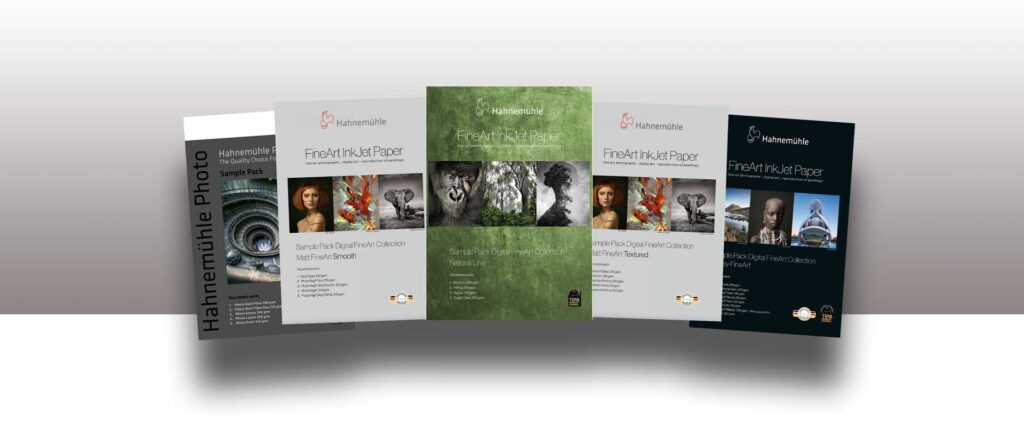Welcome to our Inkjet Paper, Fine Art, and Photography Printing Glossary. From ‘Archival’ to ‘Pigment Ink,’ this guide decodes essential terms for navigating the world of printing. Explore key concepts to enhance your understanding and elevate your print projects.
100% Cotton
Papers labeled as 100% Cotton have a base made from 100% cotton fibers. Often referred to as “Cotton Rag” or simply “Rag”. 100% Cotton papers have gained a reputation for being not only strong and durable but for having a luxurious feel. These papers are traditionally smooth or textured with a Matt surface. Making them suitable for Fine Art reproductions, however, 100% cotton photographic papers with gloss or lustre surfaces are becoming more commonplace.
Acid Free
Acid Free refers to papers where the base has a pH above 7.0. Manufacturers often add alkaline chemicals, such as calcium carbonate, to neutralise naturally acidic base pulp during its production. Acid Free papers are often classified as being “archival”, the omission of acid in the base means the paper is not susceptible to the natural degradation and yellowing that occurs in papers with an acidic base. Prints with Acid Free papers, combined with pigment based inks are what’s classified as Giclée.
Read our Blog to learn more – Acid in Photo/Fine Art Papers
Alpha Cellulose
Alpha Cellulose is a major component of wood pulp which is highly purified and process to remove impurities. This Alpha Cellulose pulp is used to make the base of many photographic and Fine Art papers prior to the inkjet receivable coating/inkjet receiving layer being applied. The majority of digital photo papers are made from Alpha Cellulose however there are some instances where photographic papers are made from 100% Cotton.
Archival
Archival papers are made from alpha cellulose, cotton, rice and other materials, or sometimes a combination of these. Sometimes referred to as museum grade or museum quality, archival papers are characterised by the permanence and longevity of the final print due to the careful manufacturing process that ensures the papers aren’t susceptible to degrading or yellowing over time. According to ISO 11108, for a paper to be considered archival is must meet the following criteria:
1. Acid-Free and Lignin-Free: Archival paper must be acid-free or possess a neutral pH above 7. It should also be devoid of lignin, a substance that can contribute to paper deterioration.
2. Absence of Unbleached Cotton: The paper should not contain unbleached cotton, as it can lead to a decrease in longevity.
3. Optical Brightening Agents (OBAs) Free: Archival paper should be free of optical brightening agents (OBAs), which are chemical compounds that can alter the appearance and potentially compromise the longevity of the paper.
Barium Sulphate
Barium Sulphate is a key ingredient in Baryta papers, papers developed to mimic traditional darkroom papers. The Barium Sulphate layer is applied before the ink receiving coating is applied and serves a number of different purposes; it contributes to the papers brightness and whiteness due to it’s ability to scatter light effectively, it also helps with ink absorption to create particularly vibrant colours or deep blacks. The added durability it provides is valuable for producing long-lasting prints.
Baryta/Fibre Based Baryta
Baryta, sometimes known as Fibre Based Baryta, is a common categorisation of inkjet papers distinguished by the inclusion of a Barium Sulphate layer that is applied to the Alpha Cellulose or Cotton base prior to the inkjet receiving layer being applied. These papers were developed to replicate the traditional darkroom papers that have a lightly textured stippled surface and a feel that typically more rigid than digital photo inkjet papers. Baryta papers typically benefit from being able to produce deep blacks (especially when printing monochrome!) and vibrant colours with subtle tonal transitions. All Baryta papers with have some level of sheen and will produce bright vibrant prints.
Base/Base Construction
Base/Base Construction is the generic term for the primary layer of the inkjet paper, manufacturers will then take this base and apply certain coatings which help the paper absorb ink and apply the final surface finish e.g. Gloss, Matt, Lustre. Manufacturers usually make the base of inkjet papers from Alpha Cellulose (wood pulp) or Cotton, or a combination of the two. Some specialty papers incorporate other materials such as Rice, Sugar Cane, or Agave.
Cotton Rag
Cotton Rag, sometimes know as “rag paper” or simply “rag” refers to papers that have a base made from 100% cotton fibres. These papers have earned a reputation for their strength, durability, and an added touch of opulence. These papers typically feature a traditional smooth or textured matte surface, making them a preferred choice for Fine Art reproductions. However, there is a growing trend toward the availability and usage of 100% cotton photographic papers with glossy or lustrous finishes, expanding the options for artists and photographers alike. This transition toward gloss and lustre surfaces in cotton-based photographic papers highlights the versatility of cotton as a medium, allowing for the preservation of its luxurious feel while adapting to evolving preferences and applications in the world of artistic and photographic printing.
Dmax/Density Maximum
DMax, or Density Maximum, is a crucial term in the realm of inkjet paper. It refers to the paper’s ability to achieve deeper, rich blacks and high contrast in printed images making it an excellent choice for monochrome and high contrast printing. A higher DMax indicates superior ink absorption and retention, resulting in sharper details and vibrant colours. For professional-quality prints and accurate image reproduction, selecting inkjet paper with a high DMax is essential. This characteristic ensures that the paper can handle the ink effectively, creating stunning visuals with the utmost clarity and impact. In essence, DMax is the key to achieving striking, high-contrast results in inkjet printing on various media types.
Dye Ink
Dye Ink is an ink technology formulated with colourants dissolved in a liquid medium making it excellent for producing vibrant and richly saturated colours. They differ to pigment based inks in that the colourant is a dye as opposed to particles of solid mater. Dye Inks are usually found at the lower end of the photographic and fine art printer spectrum however dye-based inks are particularly renowned for their ability to render smooth gradients and exceptional detail, making them a popular choice among photographers and artists especially when using glossy/lustre photographic papers. It’s important to note that while dye-based inks offer brilliant color reproduction, they may have slightly lower longevity compared to pigment-based inks. Therefore, they are often chosen for projects where immediate visual impact and color brilliance are paramount.
Giclée
Giclée printing is the highest grade of fine art and photographic reproduction. It employs high-resolution inkjet technology to create museum-quality prints with exquisite detail and color accuracy. This method uses pigment-based inks on archival-grade, acid free and OBA free paper or canvas, ensuring longevity and resistance to fading. Giclée prints faithfully capture the essence of original artworks or photographs, making them a preferred choice for artists and photographers seeking gallery-worthy reproductions. The precision, vibrancy, and archival qualities of giclee printing make it the gold standard for art enthusiasts, collectors, and professionals looking to showcase their work with stunning clarity and colour.
GSM (Grams per Square Metre)
Standing for ‘Grams per Square Meter’, GSM refers to the weight, in grams, of one square metre of an individual paper. The higher the GSM, the heavier and thicker the paper. If you’re wanting to produce prints that have a high-quality look and feel, such as for albums or exhibitions, you’ll want to choose a paper with a larger GSM.
Read our Blog to learn more – Inkjet Paper Weights Explained
ICC Profile
An ICC profile is a vital tool in the world of fine art and photographic printing. Short for “International Color Consortium,” an ICC profile is a digital roadmap that precisely defines how colours should appear on various devices, like monitors and printers. In the context of photographic and fine art printing, it ensures that the colours in a digital image match those in the final print. ICC profiles are especially crucial for achieving color accuracy, consistency, and vibrancy in fine art and photo prints. Manufacturers customize ICC profiles to specific printers, inks, and papers. While most offer generic ICC profiles for their papers for a given printer model, we recommend obtaining a custom ICC profile tailored to your individual printer for achieving the best color accuracy.
Did you know?
At Online Paper we offer a FREE Custom ICC Profile Service for any paper purchased from us. This helps our customers maximise the quality of their printing workflow. Ensuring you are achieving the highest possible level of colour accuracy for your specific printer and choice of paper.
Learn more about our FREE Custom ICC Profile Service.
Monochrome
Monochrome printing, often referred to as black and white printing, is a printing process that produces images in a single color, typically black. Printers with multiple blacks and/or greys will use a combination of these to produce the image.
Mould Made
Manufacturers design mould-made papers to replicate handmade paper through a mechanized process. The process involves picking up the pulp with a slowly rotating cylinder mould and transferring it to a felt-lined bed through varying processes depending on the paper’s requirements. Mould made papers have a stable surface and remain flat with a delicately textured surface.
OBA (Optical Brightening Agent)
Optical Brightening Agents (OBAs) play a significant role in fine art and photographic printing. Paper manufacturers often use these chemical compounds to enhance the paper’s brightness and whiteness. OBAs achieve this by absorbing ultraviolet light and re-emitting it as visible light, making the paper appear brighter. While OBAs can initially enhance the visual appeal of prints, their long-term impact on image stability and colour accuracy is a concern. Fine art and photography enthusiasts often prefer OBA-free papers for archival purposes. This is because they provide greater longevity and colour accuracy, ensuring that prints maintain their true character over time.
Read our Blog to learn more – OBAs (Optical Brightening Agents) in Inkjet Papers – An Overview
Pigment Ink
Pigment-based ink stands as the premium ink technology within the fine art and photographic printing world. Unlike dye-based inks, it features microscopic solid color particles suspended in a liquid medium. This unique composition grants pigment inks exceptional longevity and resistance to fading, making them the preferred choice for archival-quality prints. Pigment-based inks produce stunning, fade-resistant images with a broad color gamut and remarkable detail. They are a top pick among artists and photographers seeking prints that endure the test of time, maintaining their vividness and integrity for 80 years plus.
Rendering Intent
Rendering intent is a method of converting colours when the colours from an image source sit outside of the colour gamut of their destination. When applying a profile for print, there will be colours that are in gamut of the source profile of your image (e.g. Adobe RGB 1998) but out of gamut of the destination ICC profile. In this situation, we need to bring the out-of-gamut colours into gamut.
Read our Blog to learn more – What is Rendering Intent when Printing?
Still confused?
If you are still confused or would like to learn more regarding anything in the world of inkjet paper or printing, please don't hesitate to get in touch.



